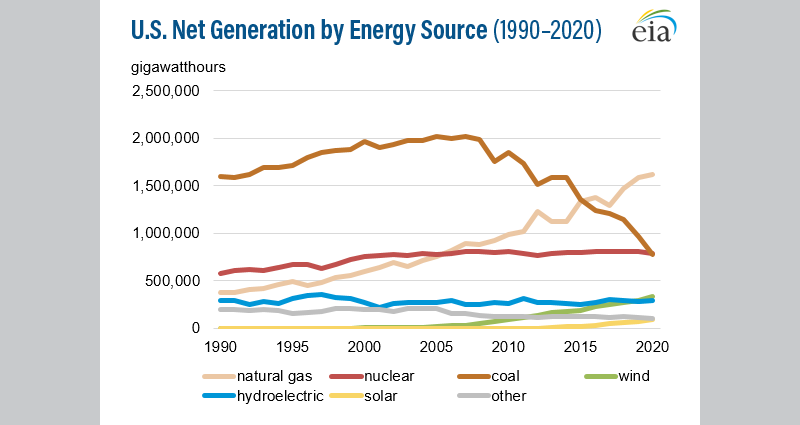Nuclear Generation Surpasses Coal-Fired Electricity in 2020

The U.S. Energy Information Administration’s (EIA) Electricity Monthly Update reported the top power generation sources in 2020 were natural gas with 1.617 million gigawatt-hours (GWh), nuclear generation with 790 terawatt-hours (TWh), coal-fired generation with 774 TWh, followed by wind, hydroelectric and solar generation sources. Wind generation surpassed hydroelectric generation in 2019 and reached 10 percent of U.S. generating capacity at the end of 2020.
Coal-fired generation has continued to decline from 1.352 million GWh in 2015, the last time it was the largest source of electricity generation in the United States. Since then, the pace of coal plant retirements accelerated while the remaining coal fleet experienced declining utilization rates. A significant portion of the coal fleet became uneconomical to run in an environment of declining wholesale power prices and increasing competition from lower-margin cost technologies, namely gas-fired generation and renewables. By the end of 2020, natural gas-fired capacity more than doubled coal-fired capacity, 482.6 GW compared with 218.4 GW.
EIA noted in its Hourly Grid Monitor report that coal-fired generation increased in January due to higher natural gas prices.
“Coal-fired generation should again increase in February as record cold across the Midcontinent spiked natural gas prices and resulted in a significant amount of gas-to-coal switching,” CFC Energy Industry Analyst Bijan Patala said. “And since natural gas prices are almost certain to rise this year from the historic lows of 2020, the industry consensus is that coal-fired generation will see its first year-over-year increase since 2014. But this should not be considered a signal of reversal of long-term market trends, as the prevailing fundamentals that have enabled the expansion of gas-fired and renewables generation in recent years remain firmly in place.”
